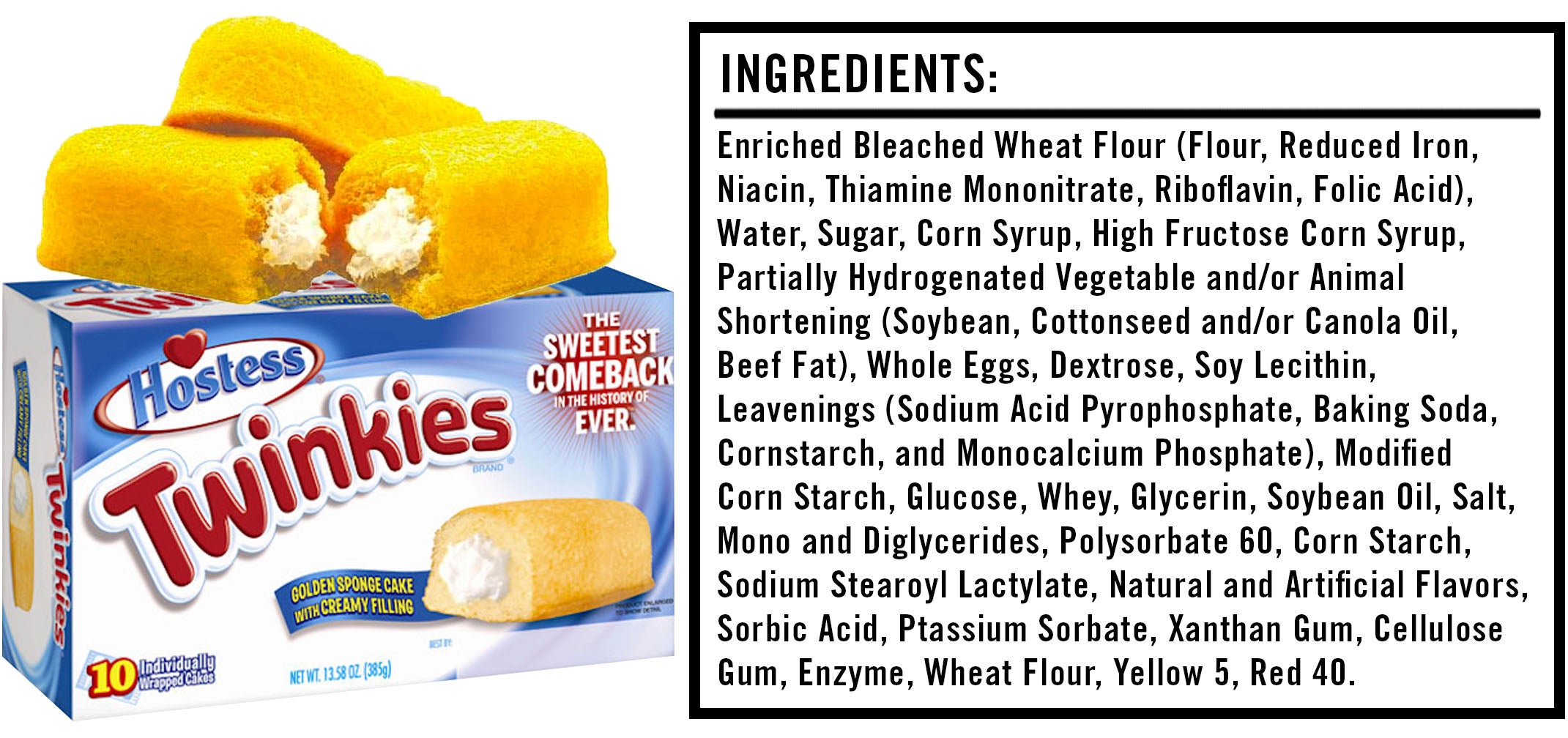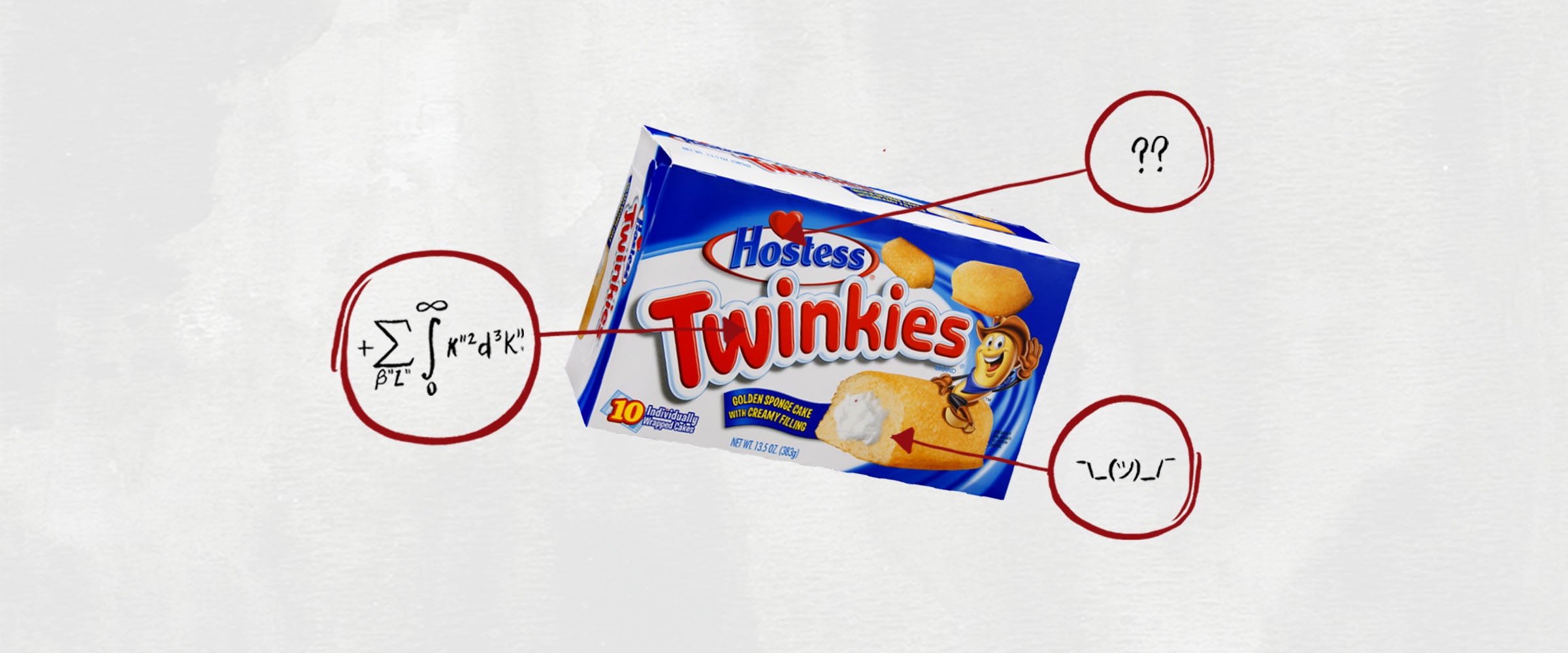We’re often told that you should never eat anything (or put anything on your body) if you don’t recognize everything on the ingredients list. But since most of us have no idea what xanthan gum or potassium benzoate are — or more importantly, what they’re doing to our bodies — we’re decoding the ingredients in the many things Americans put in (and on) themselves with the help of an expert.
This edition: Twinkies, which are made from 29 separate ingredients (some of which have ingredients lists of their own) that we’ve broken down in the exact order they appear on Instacart, since the ingredients list is nowhere to be found on their own website.
But first, be warned: The idea that Twinkies can survive the apocalypse is unfortunately a myth — while Twinkies contain several ingredients whose purpose is preservation (all of which we’ll touch on momentarily), NPR debunked the legend that claims they can last through the End Times, emphasizing that — in reality — Twinkies have a shelf-life of only 45 days.
With that, let’s dive into the ingredients…

1) Enriched Bleached Wheat Flour (Flour, Reduced Iron, Niacin, Thiamine Mononitrate, Riboflavin, Folic Acid): As we learned in our exploration of the many, many, many ingredients in the McDonald’s Big Mac, enriched flour isn’t actually “enriched” at all. In addition to containing more calories than whole wheat flour, the bleaching process enriched flour undergoes produces an unfortunate byproduct: A chemical called alloxan, which has been found to induce diabetes in lab-animal test subjects by destroying their pancreas.
2) Water: Or, H2O.
3) Sugar: Two Twinkies (one serving) contain a whopping 33 grams of sugar — or more than eight teaspoons. For reference, the American Heart Association recommends men consume no more than 36 grams and women consume no more than 25 grams of added sugar a day (and that doesn’t include sugar found naturally in foods like fruits and vegetables).
4) Corn Syrup: Corn syrup is a liquid sweetener made of glucose. It doesn’t get as much negative publicity as high fructose corn syrup (which we’ll touch on next), but regular corn syrup can also be debilitating, considering it’s basically liquid sugar.
5) High Fructose Corn Syrup: High fructose corn syrup is corn syrup that’s had some of its glucose converted to fructose enzymatically. It’s a commonly-used sweetener, and has been linked to obesity and diabetes by many, many studies. So, if possible, you want to avoid foods and drinks containing this ingredient.
6) Partially Hydrogenated Vegetable and/or Animal Shortening (Soybean, Cottonseed and/or Canola Oil, Beef Fat): According to physician and biochemist Cate Shanahan, author of Deep Nutrition: Why Your Genes Need Traditional Food, consuming too much vegetable oil — which is easy to do, considering Shanahan says roughly 45 percent of the average American’s calories come from refined oils — has serious repercussions (i.e., fatty liver disease, insulin resistance and migraines). But hydrogenated vegetable oil is even worse: When you add hydrogen to food via hydrogenation — which many manufactures do to increase the food’s shelf life — you get trans fats. Unfortunately, trans fats raise cholesterol, harden arteries and inhibit the formation of an enzyme called cyclooxygenase, which helps determine the dilation of your arteries and regulates blood flow.
While it’s near impossible to eliminate vegetable oil from your diet altogether — major contributors include processed foods, fried foods, frozen pizzas, cakes, cookies, margarines and coffee creamers — it’s best consumed in moderation.
Meanwhile, animal shortening (which is composed of beef fat in this case) can be used both as a pan coating to prevent baked goods from sticking and to give Twinkies their traditional shortbread texture, hence the name animal “shortening.”
7) Whole Eggs: From chickens.
8) Dextrose: Similar to glucose, dextrose is a sugar derived from starches. Fun fact: Dextrose has a high glycemic index, meaning it quickly raises the blood sugar levels, so it’s used in IV solutions to treat low blood sugar and dehydration. People with diabetes might also consume dextrose tablets to raise their blood sugar levels if they become dangerously low.
9) Soy Lecithin: Soy lecithin is a component of fat found in (you guessed it!) soy. It’s typically added to food products as an emulsifier. In simpler terms, it helps the numerous ingredients found in Twinkies mix together. “It’s also frequently used to extend product shelf life,” explains Dagan Xavier, ingredient expert and co-founder of Label Insight.
10) Leavenings (Sodium Acid Pyrophosphate, Baking Soda, Cornstarch, and Monocalcium Phosphate): In baked goods, sodium acid pyrophosphate and monocalcium phosphate react with baking soda to produces carbon dioxide, which helps the dough rise. When consumed in moderation, monocalcium phosphate isn’t anything to worry about; however, an excessive amount of phosphates in the diet, particularly when contained in processed foods like Twinkies, can accelerate the aging process, increase the risk of heart disease and place undue stress on the kidneys.
11) Modified Corn Starch: Modified corn starch is treated physically, enzymatically or chemically to partially break down the starch. It can be used as a stabilizer, thickening agent or an emulsifier.
12) Glucose: Glucose is a simple sugar.
13) Whey: Whey is essentially the liquid leftovers after milk has been curdled and strained. It’s usually added to processed foods as a source of protein and to add bulk.
14) Glycerin: Glycerin is often used as a thickening agent
15) Soybean Oil: See partially hydrogenated vegetable oil.
16) Salt: For flavor.
17) Mono and Diglycerides: This ingredient is typically added to food products as an emulsifier. In simpler terms, it helps all the ingredients properly blend together. But as we learned in our exploration of all 39 ingredients in the Dodger Dog, mono and diglycerides are oftentimes packed with trans fats that aren’t listed on the nutrition facts label, which is incredibly problematic. That’s because trans fats are associated with an increased risk of heart disease, stroke and diabetes, and consuming more than you think you are (because they weren’t listed on the label) could do serious damage to your body.
18) Polysorbate 60: This is an emulsifier and prevents baked goods from going stale. According to several studies, polysorbate 60 can cause organ toxicity and cancer in high doses; however, the FDA classifies this chemical as safe for limited use in food.
19) Corn Starch: This acts as a stabilizer, thickening agent or emulsifier.
20) Sodium Stearoyl Lactylate: This ingredient is a commonly incorporated in baked goods to strengthen dough, mix liquids and oils together and replace some fat and sugar. While it’s considered to be safe by the FDA, some people may experience an allergic reaction to the ingredient that consists of itching, swelling, mucus production, muscle spasms, hives and rash formation.
21) Natural and Artificial Flavor: While natural flavors are literally flavors derived from an actual food source — i.e., orange flavoring taken from a real orange — artificial flavors are chemical compounds created in a lab that mimic a natural flavor in some way. While that may sound unhealthy, as Shanahan told us during our exploration of all 26 ingredients in nacho-flavored Doritos, these flavorings are added in such small quantities that they shouldn’t cause you any harm.
22) Sorbic Acid: A preservative used for its antimicrobial properties, sorbic acid is on the FDA’s list of “generally recognized as safe” substances.
23) Potassium Sorbate: Potassium sorbate is another preservative used for its antimicrobial properties, which stop the growth and spread of harmful bacteria and molds. A 2010 study published in Toxicology in Vitro found that exposure of human blood cells to potassium sorbate in the laboratory caused DNA damage. That said, a long-term study on humans is still required to decide whether we should be worried about consuming it.
24) Xanthan Gum: This is a thickening agent.
25) Cellulose Gum: Cellulose gum is another common thickening agent. Consuming large amounts of it may add bulk to your stool and have a laxative effect, according to the FDA. Do you really have to worry about the small supply found in Twinkies? Probably not.
26) Enzyme: In bread making, enzymes help break down the starches into simple sugars, which aid in the fermentation process that results in a browned crust and well-developed flavor.
27) Wheat Flour: Wheat flour is a powder made from grinding wheat. Duh.
28) Yellow 5: Artificial colors have a bad reputation, but as Shanahan explained during our analysis of Doritos, studies arguing this are a bit flawed:
“I’ve always been of the opinion that studies claiming artificial colors can cause cancer are irrelevant because [in the studies] they use really high amounts of the artificial colors — like, a million times more than you’d ever get [in your] food [throughout your lifetime].”
All in all, the average person’s liver should be able to break down whatever minuscule amount of artificial coloring we consume with food.
29) Red 40: See above.
The Takeaway
I have nothing good to say about the ingredients found in Twinkies. They basically consist of enriched flour, hydrogenated vegetable oil, sugar and a spattering of chemicals aimed at making them last longer and taste better — but you probably already guessed that. You also probably guessed that you will no doubt pay the price if you eat too many.

